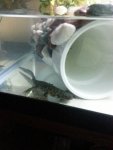ksb1001
New member
- Joined
- Nov 11, 2014
- Messages
- 19
- Reaction score
- 1
- Points
- 0
- Country
- United States
I have 2 Spanish ribbed newts (Pleurodeles waltl). I've only had them about 2 weeks. They are about 6" long each and are in a 20 gallon long tank with substrate. They get natural lighting when I leave the shades open during the day. They get no artificial lighting. Water temp maintains about 63 degrees Fahrenheit. The water has cleared 100% since the pictures were taken. It took two 50% water changes each week and the addition of a terrarium filter to get it there. (Also, in the picture of the tank, you can see a non-functional sponge filter in the back. This has since been removed and a true filter has been added.)
I am feeding them mainly bloodworms and krill (they get these every other day) and newt pellets on the days they don't get the others. On the days they get frozen food, I cut one of the blocks in half, thaw it out, and feed them on separate sides of the tank. I keep the other half frozen. I guess it would have been easier to say that each newt is getting 1/4 of a frozen cube of worms/krill each. I also put in 3 small guppies for them to eat and they were gone in an evening.
I am worried about their eating habits. I have been reading that they should only be fed 3 times a week and to expect them to not eat everything I give them. This is not the case. They are absolutely voracious eaters. Anything I put into the tank is eaten within minutes. Lemmie (the dark one) was very thin when he came to me and so was Juice (the leucistic one) but not as bad. The people I got them from said Juice will lay eggs. They were being fed only pac-man frog food at their old home. I am worried about over feeding them, but I am also worried about under feeding them. Could it be that they are just excited to have real food for once? I want to give them the best life possible, but I don't want them to become ill from over feeding. I have been keeping a close eye on the nitrate levels and they've been very low. I also keep a turkey baster on had to suck out any fecal matter or dirt from the driftwood in there.
Any input would be greatly appreciated. I'm just trying to give them a great life!
I am feeding them mainly bloodworms and krill (they get these every other day) and newt pellets on the days they don't get the others. On the days they get frozen food, I cut one of the blocks in half, thaw it out, and feed them on separate sides of the tank. I keep the other half frozen. I guess it would have been easier to say that each newt is getting 1/4 of a frozen cube of worms/krill each. I also put in 3 small guppies for them to eat and they were gone in an evening.
I am worried about their eating habits. I have been reading that they should only be fed 3 times a week and to expect them to not eat everything I give them. This is not the case. They are absolutely voracious eaters. Anything I put into the tank is eaten within minutes. Lemmie (the dark one) was very thin when he came to me and so was Juice (the leucistic one) but not as bad. The people I got them from said Juice will lay eggs. They were being fed only pac-man frog food at their old home. I am worried about over feeding them, but I am also worried about under feeding them. Could it be that they are just excited to have real food for once? I want to give them the best life possible, but I don't want them to become ill from over feeding. I have been keeping a close eye on the nitrate levels and they've been very low. I also keep a turkey baster on had to suck out any fecal matter or dirt from the driftwood in there.
Any input would be greatly appreciated. I'm just trying to give them a great life!






